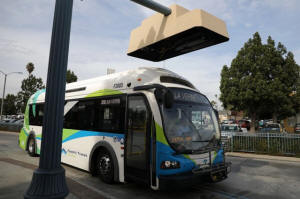|
U.S. transit agencies cautious on
electric buses despite bold forecasts
 Send a link to a friend
Send a link to a friend
 [December 12, 2017]
By Nichola Groom [December 12, 2017]
By Nichola Groom
LOS ANGELES (Reuters) - Communities across
the United States are looking to replace their dirty diesel buses,
ushering in what some analysts predict will be a boom in electric
fleets.
But transit agencies doing the buying are moving cautiously, an analysis
by Reuters shows. Out of more than 65,000 public buses plying U.S. roads
today, just 300 are electric. Among the challenges: EVs are expensive,
have limited range and are unproven on a mass scale.
A typical 40-foot electric bus costs around $750,000, compared with
about $435,000 for a diesel bus. Cheaper fuel and maintenance expenses
can lower the overall costs over the 12-year life of the vehicles. But
those costs can widely depending on utility rates, terrain and weather.
The technology is still a gamble for many cities at a time when bus
ridership is falling nationwide and officials are trying to keep a lid
on fares, says Chris Stoddart, an executive at Canadian bus maker New
Flyer Industries Inc <NFI.TO>. A top supplier of conventional buses to
the U.S. market, the company has just a handful of pure battery
electrics in service.

"People worry about being an early adopter. Remember 20 years ago
someone paid $20,000 for a plasma TV and then 10 years later it was $900
at Best Buy," said Stoddart, senior vice president of engineering and
customer service for New Flyer. "People just don't want a science
project."
Rival electric bus manufacturers expect dramatic growth; the most
ambitious forecasts call for all bus purchases to be electric by 2030.
But even green-energy advocates are skeptical of such rosy predictions.
CALSTART, a California-based nonprofit that promotes clean
transportation, figures 50 percent to 60 percent of new buses will be
zero emissions by 2030. Market research firm Navigant Research expects
electric buses to make up 27 percent of new U.S. bus sales by 2027.
NOT QUITE THERE YET
Transit agencies have found EV performance lags in extreme conditions.
In environmentally friendly San Francisco, officials have resisted
electrics over concerns about the city’s famously steep hills. "The
technology isn't quite there yet," Erica Kato, a spokeswoman for the San
Francisco Municipal Transportation Agency, said in a statement.
Weather is also a major challenge.
An electric bus tested last year near Phoenix wilted in the summer heat
due to the strains of running the air conditioning. The vehicle never
achieved more than 89.9 miles on a charge, less than two-thirds of its
advertised range, according to a report by the Valley Metro Regional
Public Transportation Authority.
In Massachusetts, two agencies running small numbers of electric buses -
the Pioneer Valley Transit Authority in Springfield and Worcester's
Regional Transit Authority - say the vehicles weaken in extreme cold and
snow. They have no plans to acquire additional EVs, officials at those
agencies said.
Even places with successful pilots have downplayed expectations.
Seattle's King County Metro transit agency soon will be operating more
than a dozen vehicles by three manufacturers, according to Pete Melin,
director of zero emission fleet technologies. The agency likes what it
has seen so far.

Still, Melin said, high electricity rates from the local utility at peak
demand periods are a concern. And the lack of a uniform charging system
among bus makers has complicated Seattle’s goal of running an
all-electric fleet by 2034.
"We have caveats to becoming zero emissions," Melin said in an
interview.
Another worry is government funding. Federal money for bus purchases is
about 25 percent lower than it was five years ago, according to Rob
Healy, vice president of government affairs for the American Public
Transportation Association.
An Obama-era program that sets aside $55 million a year in grants to
help transit agencies purchase clean buses will expire in 2020 if not
renewed by Congress.
THE EV BUS HEAVYWEIGHTS
In addition to New Flyer, the fledgling U.S. electric bus industry has
two other major players: Chinese automaker BYD, which is backed by
Warren Buffett's Berkshire Hathaway Inc <BRKa.N>; and Silicon Valley
startup Proterra Inc.
[to top of second column]
|

An electric bus sits under a charging station in Pomona, California
U.S. November 16, 2017. REUTERS/Lucy Nicholson

BYD and Proterra began selling electric buses into the U.S. market
several years ago, and have 165 and 126 vehicles on the road today,
respectively.
Both are ramping up U.S. manufacturing on expectations that EVs will
account for nearly all new bus sales in a little over a decade. BYD
has a plant in Lancaster, California, while Proterra has
manufacturing facilities in City of Industry, California and
Greenville, South Carolina.
Buffett paid $230 million for a 10 percent stake in BYD in 2008.
Today the company has a market capitalization of $25 billion, thanks
mainly to China's aggressive move to electrify transportation. More
than 15 percent of the 608,600 buses in China are pure electric,
according to government data. Proterra investors include venture
capital firm Kleiner Perkins Caufield & Byers and the venture
capital arm of General Motors Co <GM.N>. Proterra, based in
Burlingame, California, is planning an initial public offering, but
would not give a timeline for the debut.
Chief Executive Ryan Popple said range is improving quickly. The
company is currently shipping models with up to 350 miles of range,
but new battery technology is expected to boost that by nearly 30
percent.
“We’re starting to outstrip the market requirement in terms of what
city buses actually do,” Popple said. "It opens up new markets for
us."
Notably, Proterra’s growth should also lift the fortunes of U.S.
wind blade maker TPI Composites Inc <TPIC.O>, which struck a deal to
build up to 3,350 lightweight bus bodies for the EV bus maker over
the next five years. Raymond James analyst Pavel Molchanov estimated
the deal could account for 12 percent of Scottsdale, Arizona-based
TPI’s revenue in 2019.

Winnipeg-based New Flyer, meanwhile, has won some big orders,
including a deal to supply up to 100 electric buses to Los Angeles
County Metropolitan Transportation Authority. Still, company
executives view electrification as a gradual transformation.
“It’s going to be a slow, methodical rather than an absolute
disruption type environment," CEO Paul Soubry said on a conference
call with analysts last month.
WORKING WELL, WITH TRADE-OFFS
Despite the technology's limitations, some U.S. transit agencies are
hitting the accelerator on their electric conversions. IndyGo, which
serves greater Indianapolis, has struck a deal with BYD to purchase
31 electric buses, with the option to add dozens more, in addition
to the 21 already in its fleet, according to an IndyGo board of
directors meeting report from July. Agency spokesman Bryan Luellen
said the EVs have reduced fuel and maintenance costs by up to half
compared to conventional buses.
Foothill Transit, in Southern California, has been operating
Proterra buses since 2010. It now has 17 in its fleet, with 13 more
scheduled to arrive before the end of the year, according to
spokeswoman Felicia Friesema.
Still, both agencies acknowledged trade-offs due to the limited
range of these vehicles. Foothill has mainly confined its electric
buses to a short 16-mile route. The Indianapolis EVs run primarily
during the morning and evening rush hours, not all day long like the
diesel workhorses that remain the mainstay of the fleet.
Still, IndyGo's Luellen figures the best is yet to come.
"With battery technology evolving rapidly we think it's a big
opportunity for us to maximize our budget and do more," he said.
(Reporting by Nichola Groom; Editing by Sue Horton and Marla
Dickerson)
[© 2017 Thomson Reuters. All rights
reserved.]
Copyright 2017 Reuters. All rights reserved. This material may not be published,
broadcast, rewritten or redistributed.
 |